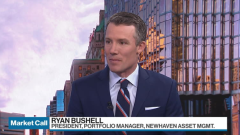Jan 30, 2024
Global Cross Border Money Flows Are Picking Up From a Record Low
, Bloomberg News

(Bloomberg) -- The flow of money moving across borders is rebounding from a record low as investors prepare for interest-rate cuts globally, according to the world’s largest custodian bank.
US and European investors are deploying more cash into fixed income and equity markets outside their home region, according to data from Bank of New York Mellon Corp., which has a view on nearly $50 trillion of assets.
It’s a sea change from last year, when the prospect of ever higher rates and the risk of recession left investors cautious and anchored at home. But with inflation and economic troubles cooling across the world and risk appetite increasing, they are keen to deploy cash elsewhere, said Jason Vitale, head of global markets trading at BNY Mellon.
“We are now seeing active investors shift back into public markets, with flows recovering into both developed and emerging markets,” Vitale said in an interview. US investors represent around 60% of BNY Mellon’s custody accounts, with the rest spread across Europe and the UK.
Last year US money market funds ballooned to a record as the Federal Reserve raised rates aggressively and investors flocked to safety. Meanwhile, the bias to own US equities, amid hype around artificial intelligence, meant it was the worst 12 months for cross-border flows since BNY started recording data in 2013.
While the S&P 500 Index has continued upward to hit a fresh record in January, in recent months emerging-market stocks have also recovered on the prospect of Fed cuts, and they’ve rebounded again this month on China’s stimulus measures.
Developing-nation stocks had a record $12.1 billion of inflows in the week through Jan. 24, according to Bank of America Corp., citing EPFR data. Chinese funds had the largest inflows since July 2015 at $11.9 billion, the second-highest ever. In developed markets, Japanese stocks and a European benchmark reached multi-decade highs.
Read more: BofA Says China Leads Historic Flows Into Emerging-Market Stocks
Global bonds have also rallied, with record debt sales by European governments this month drawing historic demand from central banks and funds based in the Middle East and Asia.
In the $7.5 trillion-a-day currency market, the greater cross border flows mean there’s a resurgence in hedging activity. BNY Mellon is seeing a hunt for battered currencies, in a renaissance of a so-called value-trading strategy, as investors look overseas for cheap fixed income and equity buys.
“Internationally focused strategies, relative value and macro portfolios are much more active compared to 2023,” said Vitale. “We are seeing clients take more active steps to hedge their portfolios compared to the last 18 months.”
BNY Mellon started Universal FX in October, a platform to help clients manage portfolios and settlement risk. That move came ahead of a regulatory shift from May that will see the US speed up the time it takes time to complete an equity trade to just one day, increasing the chance of failed currency settlements. Vitale is concerned clients outside the US are not prepared for this change, which he describes as a “transformative trend.”
Read more: Asset Managers Warn of Failed Trades as US Market Speeds Up
The pick-up in cross border flows is also anticipated to increase currency swings and boost volumes. Over the last two months, FX volatility has already picked up from the lowest level since March 2022.
“While the world was sitting in cash in 2023, the FX market was sitting in purgatory,” Vitale said. “However the set up for 2024 changes this dynamic.”
©2024 Bloomberg L.P.






